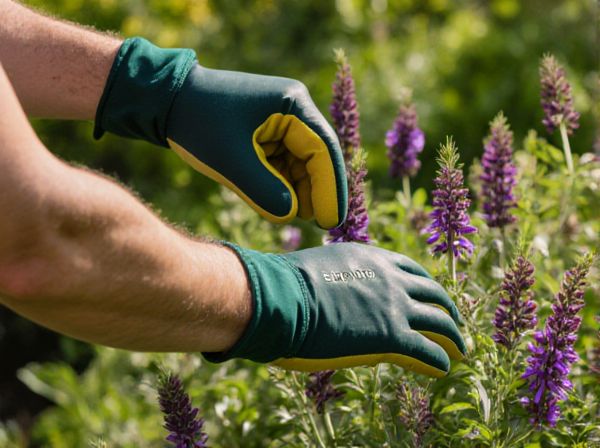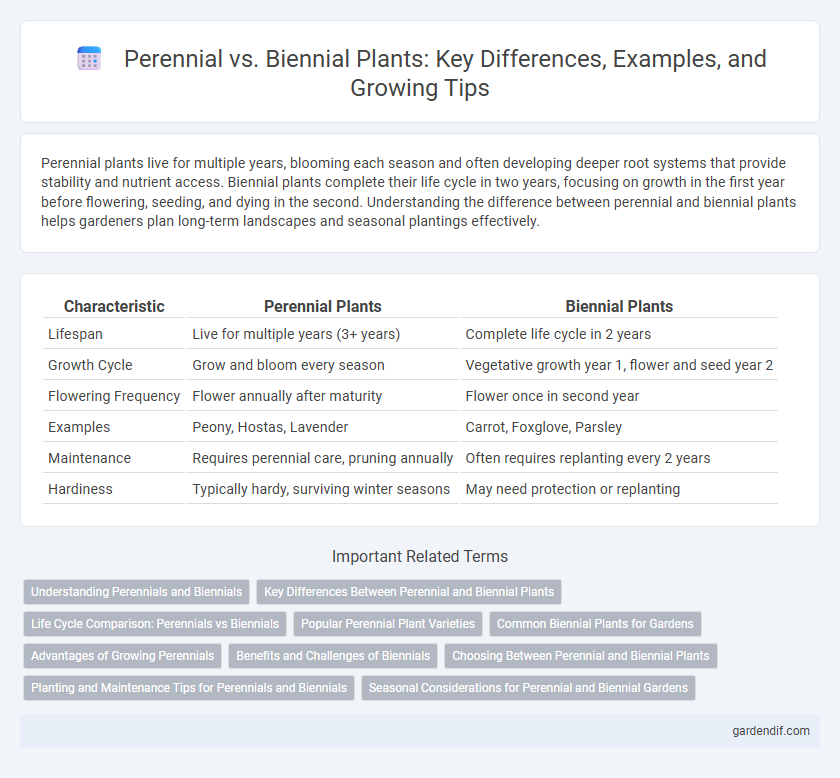
Perennial vs Biennial Illustration
Perennial plants live for multiple years, blooming each season and often developing deeper root systems that provide stability and nutrient access. Biennial plants complete their life cycle in two years, focusing on growth in the first year before flowering, seeding, and dying in the second. Understanding the difference between perennial and biennial plants helps gardeners plan long-term landscapes and seasonal plantings effectively.
Table of Comparison
| Characteristic | Perennial Plants | Biennial Plants |
|---|---|---|
| Lifespan | Live for multiple years (3+ years) | Complete life cycle in 2 years |
| Growth Cycle | Grow and bloom every season | Vegetative growth year 1, flower and seed year 2 |
| Flowering Frequency | Flower annually after maturity | Flower once in second year |
| Examples | Peony, Hostas, Lavender | Carrot, Foxglove, Parsley |
| Maintenance | Requires perennial care, pruning annually | Often requires replanting every 2 years |
| Hardiness | Typically hardy, surviving winter seasons | May need protection or replanting |
Understanding Perennials and Biennials
Perennial plants live for more than two years, continuously growing and blooming each season, while biennials complete their life cycle in two years, typically flowering in the second year before dying. Understanding the differences in their lifecycle helps gardeners plan for long-term garden design and seasonal blooms. Perennials often require less replanting, whereas biennials provide a unique opportunity to change garden compositions annually.
Key Differences Between Perennial and Biennial Plants
Perennial plants live for more than two years, continuously growing and blooming each season, while biennial plants complete their life cycle in two years, focusing on vegetative growth in the first year and flowering in the second. Perennials develop extensive root systems that allow survival through adverse conditions, whereas biennials often die after seed production in their second year. These growth patterns influence garden planning and plant selection, optimizing long-term landscape sustainability or seasonal color displays.
Life Cycle Comparison: Perennials vs Biennials
Perennial plants live for multiple years, producing flowers and seeds each growing season after reaching maturity, while biennial plants complete their life cycle in two years, typically focusing on vegetative growth in the first year and flowering in the second before dying. Perennials invest energy in long-term survival structures such as roots or woody stems, enabling repeated growth cycles, whereas biennials allocate resources to complete reproduction efficiently within a two-year timeframe. Understanding these differences in life cycle strategies helps in garden planning and crop rotation for sustainable plant management.
Popular Perennial Plant Varieties
Popular perennial plant varieties include hostas, daylilies, and peonies, known for their ability to thrive year after year with minimal maintenance. Unlike biennials that complete their life cycle in two years, perennials regrow from the same root system, providing consistent blooms and foliage. Gardeners often prefer perennials for their durability, long-lasting beauty, and ability to establish a stable ecosystem in the garden.
Common Biennial Plants for Gardens
Common biennial plants for gardens include foxglove (Digitalis purpurea), hollyhock (Alcea rosea), and sweet pea (Lathyrus odoratus), which complete their life cycle in two years, producing foliage the first year and flowering the second. These plants provide gardeners with striking seasonal interest and are ideal for mixed borders and cottage-style gardens. Biennials require specific care such as biennial rotation and protection during the first winter to ensure successful blooming the following year.
Advantages of Growing Perennials
Perennial plants offer long-term cost savings and reduced maintenance as they regrow year after year without the need for replanting. Their deep root systems enhance soil stability and improve water retention, promoting healthier garden ecosystems. Perennials also provide consistent seasonal blooms, attracting pollinators and supporting biodiversity over multiple growing seasons.
Benefits and Challenges of Biennials
Biennial plants offer benefits such as extended growth cycles, allowing for root and foliage development in the first year and flowering in the second, which can improve biomass and nutrient storage. Challenges include the need for two growing seasons to complete their life cycle, making crop rotation and garden planning more complex. They are also more susceptible to environmental stress during overwintering compared to perennials or annuals.
Choosing Between Perennial and Biennial Plants
Choosing between perennial and biennial plants depends on garden design, maintenance preferences, and growth cycles. Perennials, like peonies and hostas, live for multiple seasons, offering long-term color and structure with less frequent replanting. Biennials, such as foxglove and sweet William, complete their life cycle in two years, providing quick blooms and opportunities for crop rotation or seasonal variety in planting schemes.
Planting and Maintenance Tips for Perennials and Biennials
Perennial plants require planting in well-drained soil with consistent moisture and benefit from mulching to maintain soil temperature and reduce weeds. Biennials need careful timing, often planted in late summer or early fall, allowing a first-year vegetative phase before flowering in the second year. Both types thrive with regular monitoring for pests, proper pruning after flowering, and nutrient-rich soil to support their growth cycles.
Seasonal Considerations for Perennial and Biennial Gardens
Perennial plants thrive across multiple growing seasons, requiring seasonal pruning and mulching to enhance winter survival and spring regrowth. Biennial plants complete their lifecycle over two years, with the first season dedicated to foliage development and the second to flowering and seed production. Gardeners must plan for biennials' dormancy periods and timing of flowering in the second year to ensure optimal garden aesthetics and productivity.
Perennial vs Biennial Infographic

 gardendif.com
gardendif.com